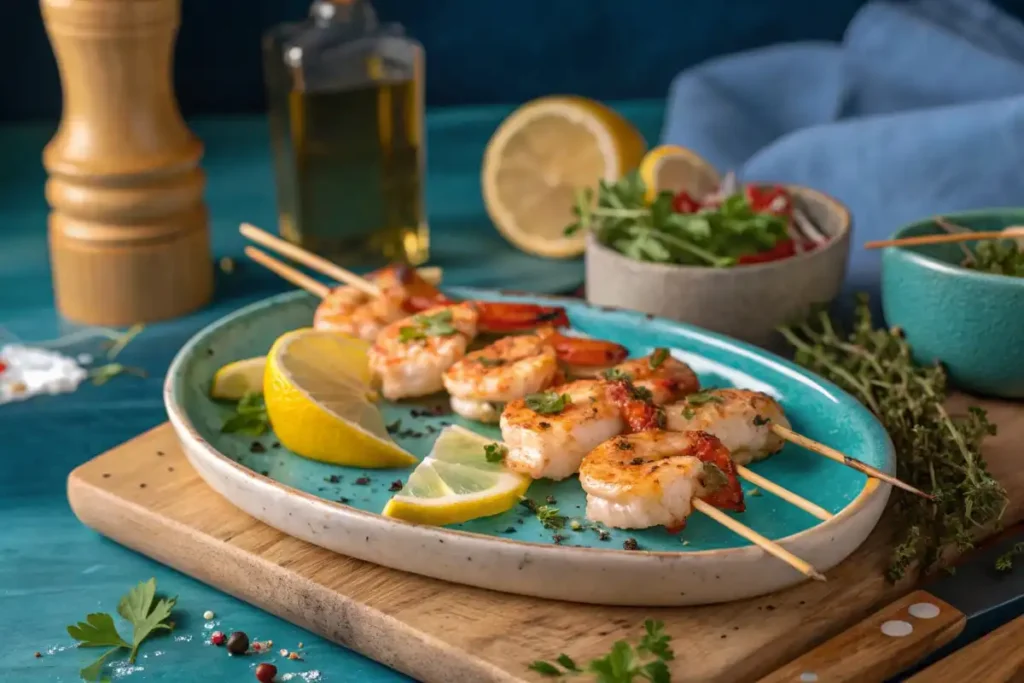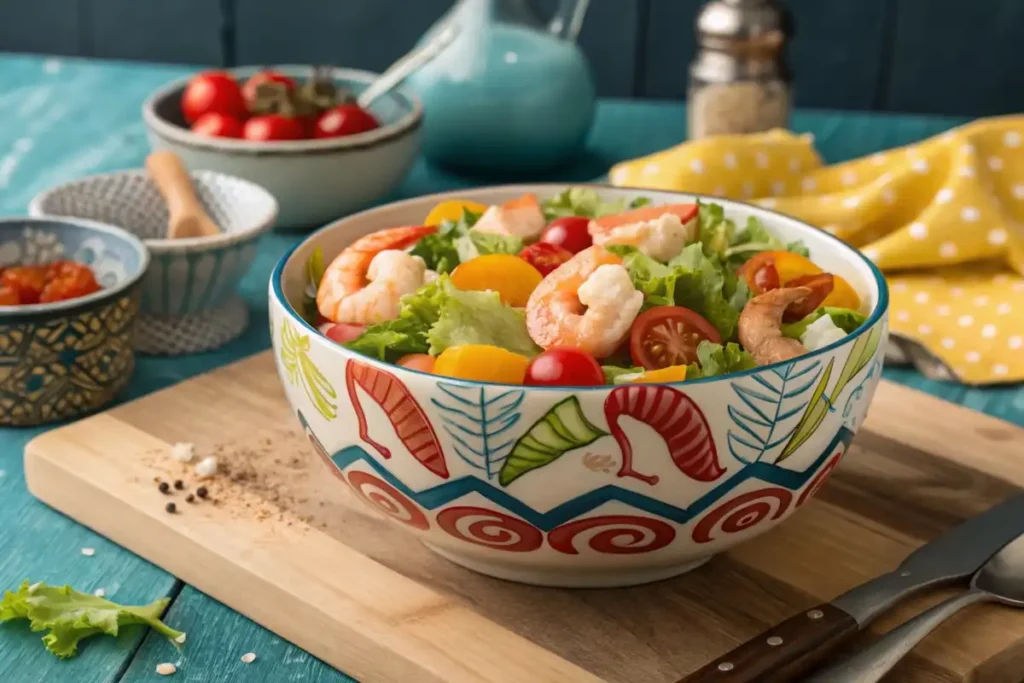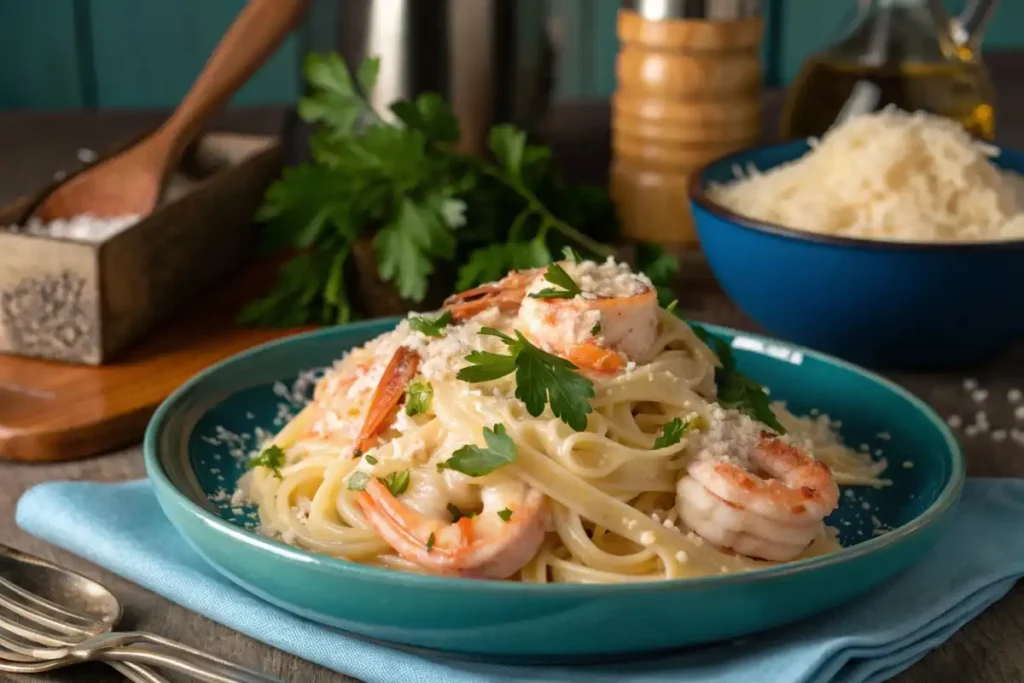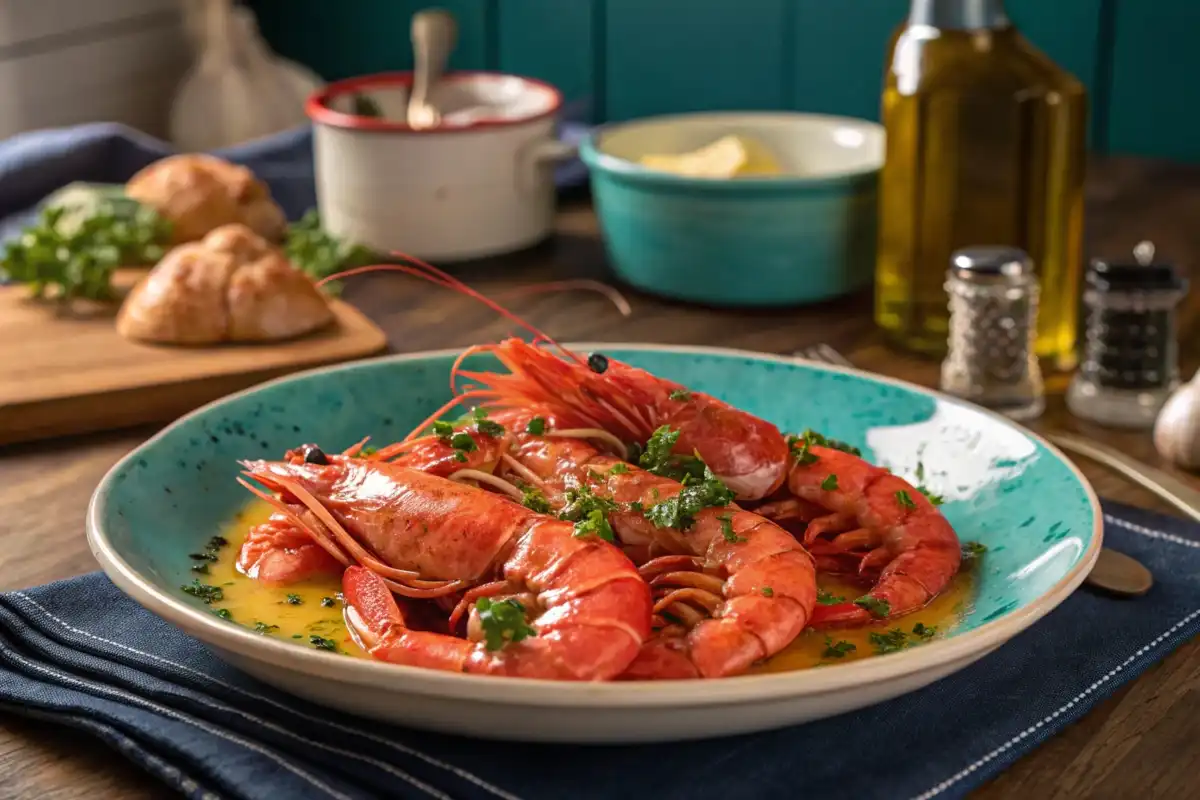Langostino tails are bite-sized, sweet, and delicate seafood treasures. At the present time, many U.S.-based food lovers want to discover these tender shellfish morsels. They look like tiny lobsters, yet they taste similar to a mix of crab and shrimp. In contrast to large lobster claws, langostino tails offer a smaller, more manageable size that still delivers big flavor. Because they are so versatile, they fit into salads, soups, and many other dishes.
In addition, langostino tails are easy to prepare and cook. For instance, you can quickly sauté them with garlic butter or add them to a creamy pasta sauce. Many home cooks appreciate them for their mild, slightly sweet flavor and tender texture.
Furthermore, their growing availability in supermarkets and online stores makes it easier than ever to add them to your weekly menu. In conclusion, these tasty morsels can upgrade any meal, providing a unique and delightful seafood experience.
What Are Langostino Tails?
Langostino tails are the small, meaty tail portions of a certain type of crustacean. Although people often confuse them with lobster or shrimp, they are neither. They come from squat lobsters, which are not true lobsters.
However, they share a similar taste profile, delivering a mild sweetness with a firm bite. In contrast to shrimp, they have a more delicate, lobster-like flavor. Because of their size, they work perfectly in small bites or as a topping.
Their bright red shells, once cooked, and tender white flesh make them visually appealing.
At the present time, many U.S. grocers and seafood markets carry frozen or fresh langostino tails. Therefore, you can easily add them to your cooking rotation. Moreover, their simple preparation methods mean even beginner cooks can enjoy them. In the meantime, food enthusiasts appreciate them for their versatility and unique taste.
History and Origin of Langostino Tails
These delicious crustaceans hail from cold and warm waters, depending on the species. They are often harvested from coastal regions, including parts of Chile, where some of the best langoustine tails are sourced.
Because they are smaller than traditional lobsters, they became popular for their convenient bite-sized form. Over time, as global seafood distribution improved, U.S. consumers have enjoyed increased access to langostino tails.
In the past, langoustine tails were less common in the American market. However, the rise of international trade changed that. Now, many specialty seafood suppliers and even major grocery chains carry them.
Their growing presence in the U.S. culinary scene reflects an evolving interest in diverse seafood options. Today, they appear in restaurants, recipes, and cookbooks, delighting diners with their sweet, delicate flavor.
Why Choose Langostino Tails Over Other Seafood?
Choosing langostino tails provides several benefits. First, their flavor profile is unique. They combine the sweetness of lobster with the tenderness of crab, offering a distinct eating experience.
Second, they are easy to handle. Because they come in small pieces, you can measure portions with ease. Third, they cook quickly. For instance, you can whip up a langoustine tails pasta dish in under 20 minutes.
Furthermore, they offer a lean source of protein. In addition, langostino tails provide essential vitamins and minerals. They can be part of a balanced, health-focused diet.
To demonstrate, a typical serving contains protein, selenium, and various B vitamins. Another reason they stand out is their adaptability. Whether you want to stir them into a chowder or place them atop a salad, they fit almost any meal plan.
In contrast, other shellfish may be less versatile or more time-consuming to prepare.
Nutritional Benefits of Langostino Tails
Because langostino tails are nutrient-rich, they can support a healthy diet. They are relatively low in fat while providing quality protein. In addition, they offer minerals like calcium and iron.
Consuming them can help maintain healthy muscles, bones, and immune function. Furthermore, they are low in calories compared to many other seafood options, making them appealing to those watching their weight.
Including langoustine tails in your meal plan can boost your intake of beneficial nutrients. For example, they contain Omega-3 fatty acids, which support heart health. Also, they provide selenium, known to aid immune function.
It is worth noting that langostino tails are naturally gluten-free, fitting into various dietary needs. Therefore, they make a great choice for those seeking variety and nourishment.
Nutritional Data (per 3 oz. serving)
| Nutrient | Amount (Approx.) |
|---|---|
| Calories | 90 |
| Protein | 15 g |
| Total Fat | 1 g |
| Saturated Fat | 0.2 g |
| Cholesterol | 60 mg |
| Sodium | 190 mg |
| Carbohydrates | 0 g |
| Fiber | 0 g |
| Sugars | 0 g |
| Vitamin B12 | 20% DV |
| Selenium | 35% DV |
| Iron | 4% DV |
| Calcium | 2% DV |
(Note: Values are approximate and can vary depending on preparation and source.)
How to Buy and Store Langostino Tails
At the present time, you can purchase langostino tails at many supermarkets and seafood counters. If they are not available in local stores, online seafood retailers often deliver them frozen.
When buying, look for firm flesh and a clean smell. Because quality matters, choose a reputable seller for the best flavor.
When you bring them home, store them properly. For instance, if they are frozen, keep them in the freezer until ready to use. If thawed, store them in the refrigerator and use them within a couple of days.
Proper storage ensures top quality, maintaining flavor and texture. In addition, always handle seafood with clean hands and utensils to prevent contamination. Eventually, with the right storage, langoustine tails will be ready for your next culinary adventure.
Cooking Methods for Langostino Tails
Langostino tails lend themselves to various cooking methods. Because they are small, they cook quickly, making them ideal for fast meals. Below are a few popular methods:
- Sautéing: Heat oil or butter in a pan. Add langoustine tails and seasonings. Cook until just firm, about 2-4 minutes. For instance, try garlic, lemon zest, and parsley for bright flavors.
- Steaming: Place langoustine tails in a steamer basket over boiling water. Steam until opaque, about 3-5 minutes. In addition, serve them with melted butter or a light sauce.
- Grilling: Thread langoustine tails on skewers. Brush with oil and spices. Grill over medium heat until they turn opaque, flipping once. This adds a smoky flavor.
- Boiling: Drop langoustine tails into gently simmering water or broth. Cook for 1-2 minutes until done. In contrast to long cooking times for large lobsters, these cook faster.
- Roasting: Toss them with oil, herbs, and spices. Spread on a baking sheet. Roast at 400°F for about 5-7 minutes. This method infuses deeper flavors.
In conclusion, langostino tails are flexible and forgiving. Choose a method that suits your recipe and preference.

Flavor Pairings and Seasonings
Because langostino tails have a sweet, delicate flavor, they pair well with subtle seasonings.
For instance, butter, lemon juice, and garlic highlight their natural taste. Herbs like parsley, chives, and tarragon also work well. In addition, a pinch of paprika or mild chili flakes can add warmth without overpowering.
For creamy dishes, consider a light Alfredo or cream sauce. Alternatively, use fresh citrus and olive oil for a refreshing salad topping.
If you crave more complexity, experiment with ginger, soy sauce, or sesame oil for an Asian-inspired twist. Furthermore, they complement mild vegetables and grains, making them perfect for wholesome bowls and pasta dishes.
Best Recipes Featuring Langostino Tails
Langostino tails shine in numerous recipes. Because they are versatile, you can add them to many dishes. Consider these ideas:
- Creamy Langostino Tails Pasta: Sauté langostino tails in butter with garlic and shallots. Toss with a light cream sauce, cooked pasta, and fresh herbs. Top with grated Parmesan for a simple yet indulgent meal.
- Langostino Tails Salad: Combine chilled langostino tails with crisp lettuce, cherry tomatoes, cucumbers, and a citrus vinaigrette. In addition, add diced avocado for creaminess. This makes a healthy, protein-rich lunch.
- Seafood Chowder: Stir cooked langostino tails into a creamy corn or potato chowder. Their sweet flavor enhances the broth. Serve with crusty bread.
- Tacos with Langostino Tails: Fill warm tortillas with sautéed langostino tails, shredded cabbage, and a drizzle of lime crema. For example, top with fresh cilantro and a squeeze of lime.
- Risotto: Stir in cooked langostino tails at the end of cooking a simple seafood risotto. Add fresh peas and lemon zest for brightness.

A Simple Langostino Tails Recipe to Try at Home
Garlic Butter Langostino Tails (Serves 4)
Ingredients:
- 1 lb. of langoustine tails (thawed if frozen)
- 3 tablespoons unsalted butter
- 2 cloves garlic, minced
- 1 tablespoon fresh lemon juice
- Salt and pepper to taste
- Chopped parsley for garnish
Instructions:
- Melt butter in a skillet over medium heat.
- Add garlic and sauté until fragrant, about 30 seconds.
- Add langoustine tails and cook, stirring, for 2-3 minutes until opaque.
- Stir in lemon juice. Season with salt and pepper.
- Garnish with parsley and serve immediately.
This quick dish works well with pasta, rice, or a side of steamed vegetables. In addition, serve it as an appetizer or a main course. Because of its simplicity, even beginners can impress guests with minimal effort.

Health Considerations
Langostino tails provide lean protein and beneficial nutrients. However, those with shellfish allergies must avoid them.
Always confirm their origin and handling if you are sensitive to seafood contaminants. In contrast to some other shellfish, they have lower total fat and fewer calories.
Therefore, they are a smart choice for those aiming to maintain a balanced diet.
If you watch your sodium intake, season them lightly and choose low-sodium condiments.
Because they contain cholesterol, enjoy them in moderation as part of a varied diet. In general, langoustine tails can fit into many healthy eating plans. Speak with a healthcare provider if you have any concerns about adding new foods to your diet.
Sustainability and Sourcing
Sustainable seafood matters. Because we rely on healthy oceans, choosing responsibly sourced langostino tails supports marine ecosystems. In addition, some suppliers follow strict guidelines to reduce environmental impact.
Look for certifications from reputable organizations. This ensures you purchase from fisheries that protect habitats and maintain stable populations.
In the meantime, ask your fishmonger about the source of their langostino tails. Some retailers share detailed information about where and how they harvest them.
Supporting sustainable seafood encourages responsible practices. Eventually, this helps preserve the resource for future generations. In conclusion, making informed choices benefits both the planet and your dinner plate.
FAQs
What is a langostino tail?
A langostino tail is the edible tail portion of a squat lobster, a small crustacean. They are not true lobsters, but their flavor and texture resemble a cross between lobster and shrimp…
Is langostino a shrimp or lobster?
Langostino tails come from squat lobsters, which are neither true shrimp nor true lobsters. However, their taste and texture lean closer to lobster, with a slight sweetness and delicate bite…
Are langostino tails healthy?
Yes. Langostino tails are a lean source of protein, low in fat, and contain essential vitamins and minerals. They fit well into a balanced diet and offer nutritious value…
How do you eat langostino?
You can eat langostino tails in various ways. For instance, sauté them in butter, add them to salads, stir them into soups, or top pasta dishes. They cook quickly and adapt to many recipes…
Can I use langostino tails in seafood pasta?
Absolutely. Their sweet, tender meat works well with creamy or tomato-based sauces. In addition, they pair nicely with herbs and light spices.
Do langostino tails require special preparation?
They usually come cooked and ready to eat. Simply thaw and heat them gently. Because they are small and tender, avoid overcooking.
How can I add flavor without overpowering their taste?
Use mild seasonings like garlic, lemon, or fresh herbs. In contrast to strong sauces, gentle flavors highlight their natural sweetness.
Do langostino tails taste like shrimp?
Their flavor is similar but slightly sweeter and more delicate. Think of a subtle blend of lobster and shrimp.
Can I freeze leftover langostino tails?
Yes, if they were fresh and properly handled before. Freeze them promptly in airtight containers. Thaw and use them within a few weeks for best quality.
Conclusion
In conclusion, langostino tails bring unique flavor, versatility, and nutrition to your kitchen.
Because they are easy to prepare and adapt to many recipes, they fit any cook’s repertoire.
They deliver the sweet essence of lobster in a convenient, bite-sized form. Furthermore, they are nutrient-rich and low in fat, making them a healthy choice.
At the present time, sourcing them has never been easier, with many U.S. markets and online shops offering quality options. By choosing responsibly sourced langostino tails, you support sustainable seafood practices.
Ultimately, these small yet delicious morsels can elevate everyday meals, impress guests, and broaden your culinary horizons.
